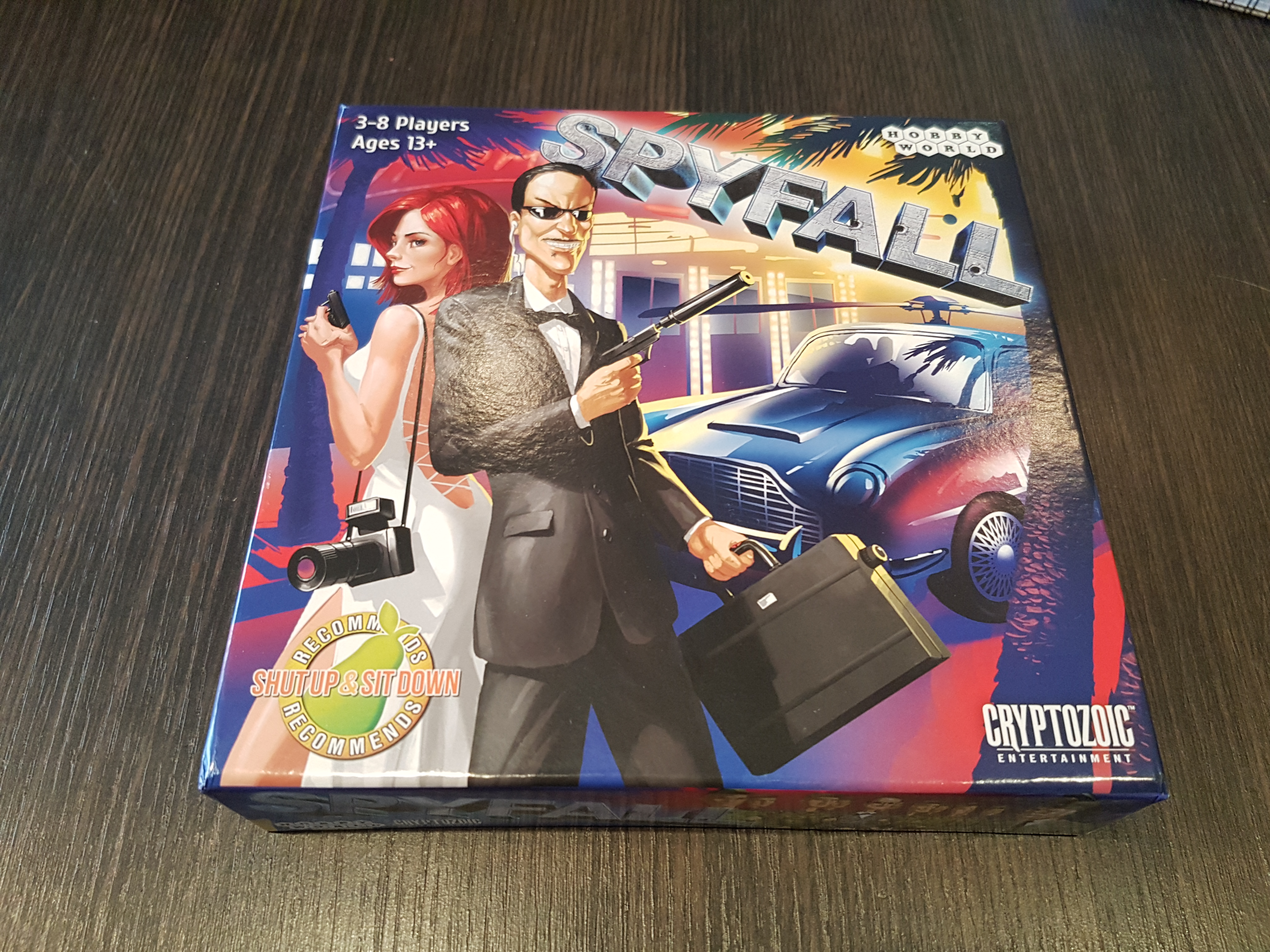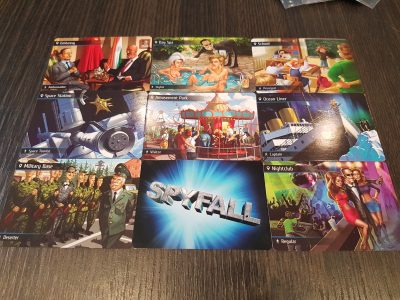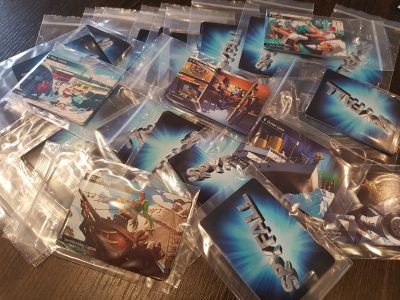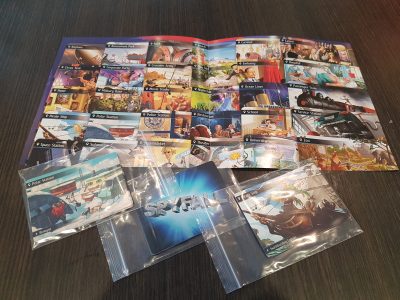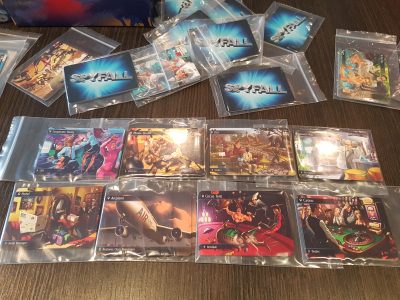Spyfall is a party card game from Cryptozoic Entertainment and designer Alexandr Ushan, released back in 2014. The game revolves around the mystery of whom the spy with a mixture of bluffing, deduction and often a fair share of laughter. Each round players will be whisked off to a random location, a place unknown to the spy. This is done by shuffling a spy card into a set of identical location cards and everyone will receive a card.
So, everyone around the table is seeing the same image apart from the spy. They must pretend to be taking in the details of the location, with only the word Spy starring back at him. After taking a few seconds to take in location, the dealer starts the eight-minute timer and the questioning. On a turn a player will ask another player around the table a single question, after answering that player then gets to ask the next question and so on. The only limitation is that you are unable to question the player whom has asked you something, keeping the game flowing around the table and stopping players feeling left out.
The objective for those with the location cards is to determine whom around the table is the spy. They’ll be unable to properly answer questions about the place. The spy is trying to ask questions and listen to answers to work out where he/she is. Be prepared to answer questions about what you can see, smell, hear and that is only the start. If the spy goes unfound for the full 8 minutes they win, however this is a rare event.
This is because at any point in the game any player can stop the timer and make a guess. Anyone can call out someone else as a spy, even the spy. This triggers a vote and if unanimous that person reveals if they are the spy or not, and the spy or the rest win the round. If the vote isn’t unanimous the timer restarts and the game continues, with that player unable to call another vote. The spy can also stop the game to guess the location. The spy must announce that they are the spy and then they can have a quick look in the rulebook at all the locations page before choosing one.
Points are awarded to the spy is they survive the 8 minutes or if they guess the location. The other players get a point if the spy is caught, with whomever called the vote getting a bonus point. Points are good to link the games together but they can easily be forgotten. This is a party game where you’ll just want to dive into the next round, forgetting the points and just getting the pleasure of winning a round is enough to keep players wanting more and more and more!
If you get the wrong group that asks the same boring questions over and over again the game rather quickly dries up. The objective of the game is to be vague and not give things away and as a result some questions such as what’s the weather like will come up. Alas, if it has been asked for the last three/four rounds it starts to tail off the excitement, almost a question that players know will come up. The energy of this game is pumped in through players coming up with weird obscure questions, or answers, and when things start to get samey it is time to box the game up and move onto something else.
Spyfall works mechanically down to the lowest player count of three all the way up to the maximum of 8. There are limitations that I would put on this though that make 5-6 the optimal player count to go with. The first issue is the win lose rate of the spy with lower player counts is heavily skewed away from the spy. Effectively with less players they have a higher percentage of being asked questions that could give them away. Almost because of this they will hear less answers from others giving them significantly less information to guess with.
At the other end of the spectrum is the full player count, where the spy could sit there without being asked a question, gleaming information from the rest. Win rate isn’t the issue here, the length of time between giving/receiving questions is. Often players can feel left out of the running, which while is great for the spy but can lead to the game becoming lacklustre for some.
When players are starting to get used to the locations and you want to add a twist to the game, Spyfall has you covered. Each of the location cards has a different job role for that location. This tiny bit of text is the only difference between the location cards which are otherwise identical. For example, in the school despite the image depicts a normal American style classroom. The job roles for the school can be anything from a Gym Teacher to a Janitor. Asking about roles can trip the spy up. Conversely, for the rest jobs can be a simple way to give the game away. When in the hospital for instance you don’t want to let on you’re a doctor, it would gift the spy brilliant information. These jobs add another layer of dodging and questioning to the game that help it stay fresh.
The strength of Spyfall is its extensive mixture of locations. There are a lot of cards in the box, 240 in total. These are split into sets of 30 rather unique locations, from the Space Station to a Beach, all with a surprising amount details. Despite all being distinct places, the background details have been carefully designed to give overlap from one location to another. The people in the background, there are beverages on show, transportation is available. These details can refer to so many of the location cards in the box yet answering these questions correctly can throw off suspicion. The balance is there so individual questions rarely give a location away, the correct combination of questions and answers though are another matter altogether.
Aside from the gameplay aspects that the cards drive the artwork is perfect for the family fun feel that Spyfall masters. A colourful cartoony style has been utilized to emphasis the friendly nature of the game whilst not compromising on the quality and detail. For a game that is literally just cards in a box it is important that these are of the high quality they are to warrant the price tag. Luckily, they are a visual treat waiting for you.
Also, let’s not gloss over the fact that 30 plastic bags are included in the box so players can easily separate out the locations. So many games fail to include enough bags in the box when there are under 100 cards, let alone 240! It certainly is a pet peeve of mine. Spyfall shows how it should be done and makes setup, packing away and all the bits between rounds more streamlined and easy for gamers.
The quality of a game can often be obvious when players are still talking about it long after the game has finished. Despite the short rounds players still get hooked up on odd questions that were asked. Many debates have been had about whether “Sunny” is an acceptable answer a question about the weather outside of a space station. Don’t even get me started on questions like “Would you feel comfortable in this situation?” Some eye-opening answers have come out from spies and non-spies alike!
This is a game that only improved round after round as players got more into the game and the call for “one more round” got louder and louder. This extends way past the first few times played as experienced players adapt their questions to give nothing away. This is only possible when players start to become familiar with the set of locations. There is a slight skew towards the spy winning if an experienced player is the spy against new players however they will soon pick up the tricks of the spy trade.
Spyfall is extremely simple to teach and play making it an amazing party game. Get the box to the table and within a minute the first round can have already started. If you don’t particularly like being put on the spot or thinking on your toes then maybe Spyfall isn’t the party game for you. At the same time after a round or two Spyfall can help people come out of their shell and start to really enjoy the evening, as the game generates plenty of laughing along the way. The design of the cards combined with the variety of locations works perfectly to balance the role of the spy and the rest. Cementing the balance is the 5 – 6 player count which I would heavily recommend, but the game works perfectly mechanically for the full 3 – 8 players. Spyfall can be group dependant as you almost need to be in the right mood, but when you are it is second to none for quick and fast fun for the whole group.
[Editor’s Note: Spyfall was provided to us by Esdevium Games for review purposes. The game is currently available on 365 Games for £18.99. It is also available from local UK board game stores, find your local store here]

